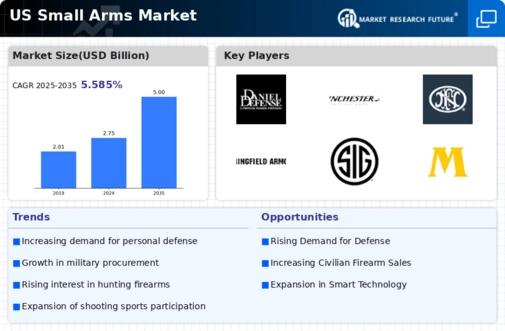Enhanced Security Concerns
In the current climate, heightened security concerns are significantly influencing the small arms market in the US. With rising crime rates and public safety issues, there is an increasing perception among citizens regarding the necessity of personal protection. This has led to a surge in firearm purchases, with estimates indicating a 15% increase in sales over the last year alone. The small arms market is responding to this demand by expanding product offerings, including handguns and self-defense weapons. As security concerns persist, the market is expected to continue its upward trajectory, driven by consumer demand for reliable personal defense solutions.
Military Modernization Initiatives
The small arms market is also being propelled by military modernization initiatives within the US. The government has allocated substantial budgets for upgrading military capabilities, which includes the procurement of advanced small arms. Recent reports suggest that military spending on small arms and related technologies could reach $5 billion by 2027. This investment not only enhances the operational effectiveness of armed forces but also stimulates the small arms market by fostering innovation and development of new products. As military contracts are awarded, manufacturers are likely to benefit from increased production and sales, further solidifying their position in the market.
Rising Demand for Recreational Shooting
The small arms market in the US is experiencing a notable increase in demand for recreational shooting activities. This trend is driven by a growing interest in shooting sports, including competitive shooting and hunting. According to recent data, participation in recreational shooting has surged by approximately 20% over the past five years. This rise is attributed to various factors, including the proliferation of shooting ranges and increased accessibility to firearms training. As more individuals engage in these activities, the small arms market is likely to see a corresponding uptick in sales of firearms and ammunition, further stimulating market growth.
Growing Interest in Firearm Customization
Customization has emerged as a prominent trend within the small arms market in the US. Consumers are increasingly seeking personalized firearms that reflect their individual preferences and needs. This trend is evidenced by a rise in aftermarket accessories and modifications, which have seen a growth rate of approximately 25% in recent years. The small arms market is adapting to this demand by offering a wider range of customizable options, including grips, sights, and finishes. As enthusiasts continue to prioritize personalization, the market is expected to expand, providing opportunities for manufacturers to innovate and cater to diverse consumer preferences.
Influence of Social Media and Online Communities
The small arms market is being significantly shaped by the influence of social media and online communities. Platforms dedicated to firearms discussions and reviews have proliferated, creating a vibrant ecosystem for enthusiasts and potential buyers. This digital engagement has led to increased awareness and interest in various firearms, contributing to a rise in sales. Recent surveys indicate that nearly 30% of firearm purchases are influenced by online research and community recommendations. As social media continues to play a pivotal role in shaping consumer behavior, the small arms market is likely to see sustained growth driven by informed and engaged consumers.
















